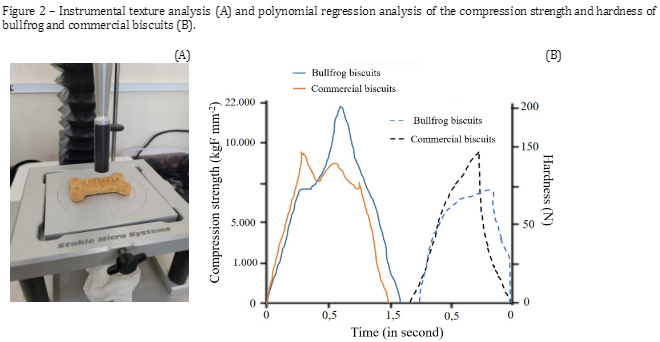Development of biscuits with viscera of bullfrog (Lithobates catesbeianus) for adult dogs
DOI:
https://doi.org/10.21708/avb.2024.18.2.12284Resumo
The study aimed to develop dog biscuits using bullfrog (Lithobates catesbeianus) viscera. After sterilizing the viscera, a pâté was produced and combined with lard, wheat flour, chemical yeast, and water to make biscuits. Microbiological safety was ensured by analyzing total mesophilic aerobes, molds, and yeasts through colony counts. The chemical composition of the biscuits (moisture, crude protein, ether extract, crude fiber, and ash) was determined. A sensory analysis, known as a preference test, was conducted where dogs were offered both the bullfrog biscuits and a well-accepted commercial brand to evaluate their preferences based on First Choice, First Consumption, and Reason for Ingestion. The commercial biscuits also underwent microbiological analysis. Results showed that both the commercial and bullfrog biscuits met international standards for mesophilic aerobes, molds, and yeasts. The proximate composition of the bullfrog biscuits was: moisture (4.52%), crude protein (14.6%), ether extract (10%), carbohydrates (68.26%), crude fiber (0.01%), and ash (1.55%), with a caloric value of 421.66 kcal per 100g. Sensory analysis revealed no significant difference in First Choice and Intake Ratio. However, dogs preferred the bullfrog biscuits for First Consumption (64.92%) compared to the commercial biscuits (35.02%). Despite the notable preference for First Consumption, no significant differences were observed for other sensory variables, suggesting that the bullfrog biscuits were well accepted by the dogs and had the potential to be a marketable product.
Downloads

Downloads
Publicado
Edição
Seção
Licença
Copyright (c) 2024 Acta Veterinaria Brasilica

Este trabalho está licenciado sob uma licença Creative Commons Attribution 4.0 International License.
Autores que publicam na Acta Veterinaria Brasilica concordam com os seguintes termos: a) Autores mantém os direitos autorais e concedem à revista o direito de primeira publicação, com o trabalho simultaneamente licenciado sob a Licença Creative Commons Attribution que permite o compartilhamento do trabalho com reconhecimento da autoria e publicação inicial nesta revista. b) Autores têm autorização para assumir contratos adicionais separadamente, para distribuição não-exclusiva da versão do trabalho publicada nesta revista (ex.: publicar em repositório institucional ou como capítulo de livro), com reconhecimento de autoria e publicação inicial nesta revista. c) Autores têm permissão e são estimulados a publicar e distribuir seu trabalho online (ex.: em repositórios institucionais ou na sua página pessoal) a qualquer ponto antes ou durante o processo editorial, já que isso pode gerar alterações produtivas, bem como aumentar o impacto e a citação do trabalho publicado (Veja O Efeito do Acesso Livre).


 Esta obra está licenciada com uma Licença
Esta obra está licenciada com uma Licença 